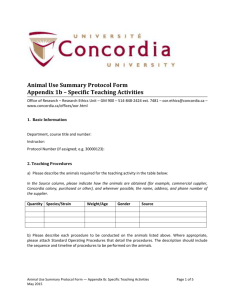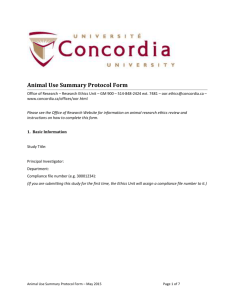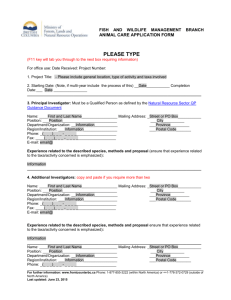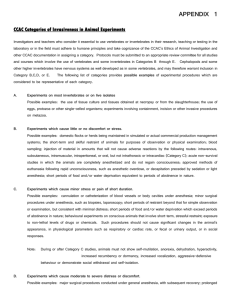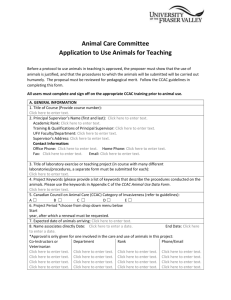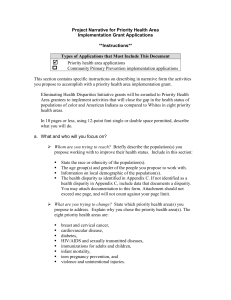Office of Research - Concordia University
advertisement
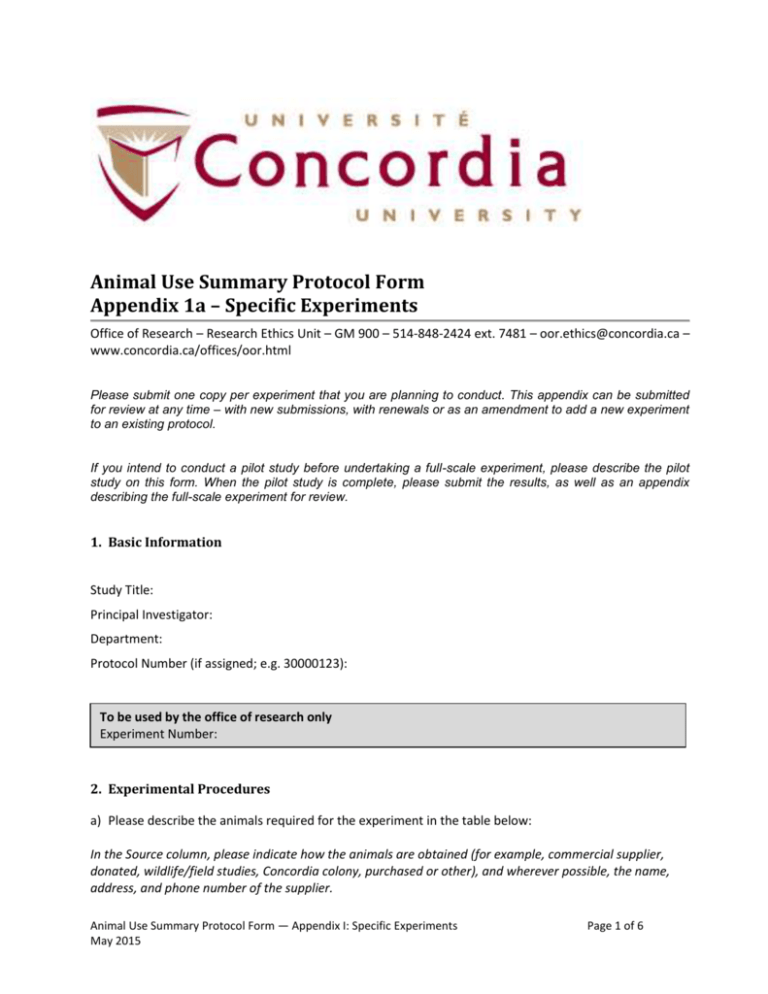
Animal Use Summary Protocol Form Appendix 1a – Specific Experiments Office of Research – Research Ethics Unit – GM 900 – 514-848-2424 ext. 7481 – oor.ethics@concordia.ca – www.concordia.ca/offices/oor.html Please submit one copy per experiment that you are planning to conduct. This appendix can be submitted for review at any time – with new submissions, with renewals or as an amendment to add a new experiment to an existing protocol. If you intend to conduct a pilot study before undertaking a full-scale experiment, please describe the pilot study on this form. When the pilot study is complete, please submit the results, as well as an appendix describing the full-scale experiment for review. 1. Basic Information Study Title: Principal Investigator: Department: Protocol Number (if assigned; e.g. 30000123): To be used by the office of research only Experiment Number: 2. Experimental Procedures a) Please describe the animals required for the experiment in the table below: In the Source column, please indicate how the animals are obtained (for example, commercial supplier, donated, wildlife/field studies, Concordia colony, purchased or other), and wherever possible, the name, address, and phone number of the supplier. Animal Use Summary Protocol Form — Appendix I: Specific Experiments May 2015 Page 1 of 6 If you intend to use or generate genetically modified animals for this experiment, please complete a copy of “Appendix 2: Genetically Modified Animals” for each strain, in addition to the table below. Quantity Species/Strain Weight/Age Gender Source b) Please describe each procedure to be conducted on the animals listed above. Where appropriate, please attach Standard Operating Procedures that describe the procedures. The description should include the sequence and timeline of procedures to be conducted on the animals. For wildlife field studies, please provide details of the pursuit, capture, housing, handling and restraint procedures. Furthermore, please describe the type of trap to be used, as well as its potential to injure animals. For experiments involving surgical procedures, please describe: A brief technical description of the surgical procedures including the preparation Monitoring, including assessment of pain and distress, during and after surgery Pain/distress management (Note that analgesics must be given to animals prior to recovery from anaesthesia and for a minimum of 24 hours following surgery. Thereafter, animals must be assessed, and if there is continuing pain or distress, analgesics will be continued in conjunction with appropriate care) The antibiotic to be administered, the dosage and route of administration Instrumentation of the animals during and after surgery, such as IV lines and catheters c) What is the highest category of invasiveness to which animals could be exposed as part of this experiment? Please refer to the CCAC website (http://www.ccac.ca/en_/standards/policies/policycategories_of_invasiveness) for complete descriptions and examples of each category of invasiveness. ☐ A: Experiments on most invertebrates or on live isolates ☐ B: Little or no discomfort or stress ☐ C: Minor stress or pain of short duration ☐ D: Moderate to severe distress or discomfort ☐ E: Severe pain near, at, or above the pain tolerance threshold of unanesthetized conscious animals Animal Use Summary Protocol Form — Appendix I: Specific Experiments May 2015 Page 2 of 6 d) Please choose the applicable classification(s): ☐ Acute: Utilizing an animal for a brief period (less than 24 hours), followed by euthanasia or return of the animal to source, or humanely euthanizing an animal upon receipt or after a brief housing period during which time no manipulations other than standard management procedures are performed, i.e. anesthetized without recovery, euthanized for tissue collection, etc. ☐ Chronic: Maintaining the animal and performing experimental procedures during this time, i.e. feeding trials, antibody production, breeding colony, recovery surgery. 3. Animal Numbers and Refinement a) For the animals undergoing the procedures described in section 2b), please describe the experimental design, explaining how the total number of animals to be used was determined, for example, 5 animals x 3 treatments x 2 replicates = 30 animals. You may wish to include a flow chart or table outlining total numbers. b) Are any additional animals required, for example, to teach surgical techniques, or to compensate for unsuccessful procedures? If so, how many? Please provide a sequential description of how these animals will be used. For example, a certain number of animals might be required to optimize procedures before proceeding with the experiment described above. c) Is the number of animals proposed for this experiment the minimum number necessary to achieve valid results? Please describe any measures used to reduce the use of animals, by minimizing number of animals and/or maximizing the scientific value of the experiment, as well as any statistical considerations. d) What refinements have been made to minimize pain, distress, or discomfort to the animals? For wildlife field studies, please describe any refinements that have been made to minimize stress due to capture, handling and other experimental procedures. 4. Animal Care a) Where will the animals be housed at each stage of the experiment? Please provide the building and room number. Where will the experimental procedures take place? Please provide the building number Animal Use Summary Protocol Form — Appendix I: Specific Experiments May 2015 Page 3 of 6 and room. If animals are housed outside of the Animal Care Facility (ACF), or if experimental procedures are conducted outside of the ACF, please provide justification, and describe how the transportation of animals, and their distress during transportation, will be minimized. Please note that university veterinarians and ACF personnel have care and oversight of all animals regardless of where they are housed. ☐ Animals will be housed in the ACF ☐ Animals will be housed elsewhere (Please provide location and justification): ☐ Experimental procedures will be performed in the ACF ☐ Experimental procedures will be performed elsewhere (Please provide location and justification): ☐ Wildlife field studies (Please specify where the study will take place and describe the facilities for any experimental procedures, as well as any arrangements for transporting wildlife from the field to the laboratory): b) How often will the research team observe or monitor the animals to assess their condition? Please attach any assessment sheets to be used to document observations or monitoring. Please refer to the animals undergoing the procedures listed above, as well as routine observations. For wildlife field studies, please specify how often traps will be monitored (if applicable), and the procedures to be followed if lactating females are trapped. Furthermore, please comment on whether the traps could capture species of animal other than the target, and any complications that could arise if this occurs. c) Will standard institutional procedures for housing and environmental enrichment be followed? If not, please describe and justify any special requirements, such as non-standard housing, or restrictions to enrichment. 5. Humane Endpoints Please note that this question refers to endpoints arising due to experimental stress or complications. Please refer to section 9 of the Animal Use Summary Protocol Form (AUSPF) for euthanasia at the end of an experiment. a) What clinical conditions or abnormalities could arise, or are expected to arise, as a result of the proposed experiment? Animal Use Summary Protocol Form — Appendix I: Specific Experiments May 2015 Page 4 of 6 b) If one the conditions or abnormalities described in 5a) arise, what endpoints should be used to determine when to intervene to alleviate an animal’s pain or distress? For mammals, this might include, for example, increased grooming, vocalization or postural changes, or physical changes such as anorexia, dehydration or diarrhea. For fish, postural or equilibrium issues, anorexia, gasping, clamped fins, fin rot, Ich and glancing could be examples of endpoints. c) What intervention is appropriate, if the animal reaches the endpoints described in section 5b), for example, euthanasia, treatment, or terminating a particular experimental procedure? If CO2 euthanasia will be used, please provide a justification, and methodology that satisfies the conditions set out in the CCAC guidance1. Please specify any analgesics and anesthetics that will be used, as well as dosages and routes of administration, procedures used to verify that and any other special procedures. For wildlife field studies, please specify the provisions for recovery, treatment or euthanasia of injured animals. 6. Emergency Care Please note that reasonable attempts will be made to contact and consult the personnel listed on your AUSPF. However, the final decision regarding emergency care is at the professional discretion of the veterinarian or the manager of the ACF. If emergency veterinary care becomes necessary, please provide information, specific instructions, indications, or contra-indications that you feel the veterinarian or manager of the ACF should be aware. ☐ Standard veterinary care is appropriate ☐ Other (please specify): 7. Declaration and Signature I declare that this Appendix to the AUSPF accurately describes the proposed animal use. I will only use animals in accordance with an AUSPF and its appendices approved by the University Animal Research Ethics Committee (UAREC). I will not deviate from this protocol unless the modification has been approved by the UAREC. 1 http://www.ccac.ca/Documents/Standards/Guidelines/Euthanasia.pdf Animal Use Summary Protocol Form — Appendix I: Specific Experiments May 2015 Page 5 of 6 I will ensure that only the personnel listed in section 2 conduct procedures involving animals under this AUSPF. I will ensure the personnel have all required training and that they are competent in executing the approved procedures. If any unexpected problems or complications involving animal health and well-being occur during this study, I will complete an Animal Incident Report and deliver it to the Manager of the ACF within 24 hours of the incident. I acknowledge that approval will expire on the date specified on the Certificate of Ethical Acceptability for Research or Teaching Involving the Use of Animals. I will not use animals after that date unless I have duly applied for renewal of my approval. I will ensure that all animals used in this protocol will be cared for in accordance with: The CCAC Guide to the Care and Use of Experimental Animals and any other applicable CCAC policy; The Concordia University Policy on the Ethical Use of Animals in Research and Teaching (VPRGS-13) and its associated procedures. This form may be submitted by e-mail in MS Word or PDF format to oor.ethics@concordia.ca. E-mail submissions sent from the researcher’s official Concordia address will be deemed equivalent to an ink-onpaper signature. Signature of Principal Investigator: ________________________________________ Date: ____________________________ Animal Use Summary Protocol Form — Appendix I: Specific Experiments May 2015 Page 6 of 6
